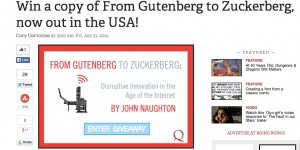Michael Lewis is, IMHO, one of the best long-form journalists around and his new book is well up to his usual standard. In many ways, it adheres to the classic Lewis formula: find a scandalous set-up of which most people are blissfully unaware; locate some smart guys who have detected the systemic scam and figured out a way to profit from their ingenuity; and then tell their story.
is well up to his usual standard. In many ways, it adheres to the classic Lewis formula: find a scandalous set-up of which most people are blissfully unaware; locate some smart guys who have detected the systemic scam and figured out a way to profit from their ingenuity; and then tell their story.
In this case, the story is basically about the speed of light – or, to be more precise, about how the time-difference (in millionths of a second) that it takes an electronic share transaction to traverse one fibre-optic connection rather than another can provide an exceedingly lucrative trading advantage to those who have the kit and the know-how to exploit it.
In the video clip he explains the nub of the idea but, as always, it’s not so much the story as the way Lewis tells it — which is why his book is a must-read for anyone who cares about this stuff.
Writing about it in Quartz, Matt Phillips quotes from another part of the TV interview
“If it wasn’t complicated, it wouldn’t be allowed to happen,” he says. ”The complexity disguises what is happening. If it’s so complicated you can’t understand it, then you can’t question it.”
“This problem”, Phillips says, “goes beyond stock markets: The US financial system is awash in unnecessary complexity. And the reasons are simple: Complexity is profitable and it keeps regulators at bay. ”The jargon of bankers and banking experts is deliberately impenetrable,” wrote economists Anat Admati and Martin Hellwig in their indispensible The Bankers’ New Clothes: What’s Wrong with Banking and What to Do about It . “This impenetrability helps them confuse policy makers and the public.”
. “This impenetrability helps them confuse policy makers and the public.”
There are some echoes of the sub-prime/CDO scandal in Lewis’s new book, in that the people who are supposed to understand how the system worked had little or no idea what was going on under their corporate noses. He recounts how the ‘good’ guys in his tale discovered this when they sought to enlighten leading figures in the financial world about flash trading:
The most sophisticated investors didn’t know what was going on in their own market. Not the big mutual funds, Fidelity and Vanguard. Not the big money-management firms like T. Rowe Price and Capital Group. Not even the most sophisticated hedge funds. The legendary investor David Einhorn, for instance, was shocked; so was Dan Loeb, another prominent hedge-fund manager.
This is an indicator of a really serious underlying problem in our networked world — the stupendous power that superior knowledge, IQ and technical understanding confers on some people. We are completely dependent on systems that are so complex that virtually nobody understands how they work — and how they can be manipulated and gamed by those who do understand them. The obvious rejoinder is “twas ever thus”, but I think that’s too complacent. What’s different now is that the level of technical expertise needed is beyond the reach or capacity of almost everyone. Which means that the elites who do ‘get’ it — and those who employ them — have colossal advantages.
LATER The book has made a BIG impact, to judge from the media coverage, and mostly the reactions have been complimentary. But there were a few contrary opinions. And Andrew Ross Sorkin, writing in the New York Times made some good points.
There is only one problem with Mr. Lewis’s tale: He reserves blame for the wrong villains. He points mostly to the hedge funds and investment banks engaged in high-frequency trading.
But Mr. Lewis seemingly glosses over the real black hats: the big stock exchanges, which are enabling — and profiting handsomely — from the extra-fast access they are providing to certain investors.
While the big Wall Street banks may have invented high-speed trading, it has gained widespread use because it has been encouraged by stock markets like the New York Stock Exchange, Nasdaq and Bats, an electronic exchange that was a pioneer in this area. These exchanges don’t just passively allow certain investors to connect to their systems. They have created systems and pricing tiers specifically for high-speed trading. They are charging higher rates for faster speeds and more data for select clients. The more you pay, the faster you trade.
That is the real problem: The exchanges have a financial incentive to create an uneven playing field.
Footnote: Readers on IoS devices may not be able to see the video clip, for reasons best known to the late Steve Jobs.

